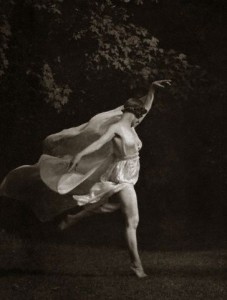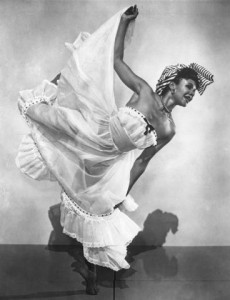After a prolonged period of delighting in the occasional film or performance of contemporary dance (especially the work of Mark Morris) while bemoaning my lack of knowledge of the broader context of dance in the 20th century, I’ve begun an intensive self-directed crash course in the history of Modern dance. I’ll be pursuing this study through the end of May, alongside the similarly dance-interested John Resig. Our explorations will be thoroughly documented on this blog.

Isadora Duncan
Step One in our curriculum: survey the territory. Last night we watched hour-long documentary film Dancing: The Individual and Tradition (1993, directed/produced by Ellen Hovde and Muffie Meyer). The film is available streaming online to Boston Public Library card-holders through the Dance in Video online archive.
I’ve also begun reading No Fixed Points: Dance in the Twentieth Century by Nancy Reynolds and Malcolm McCormick (Yale UP, 2003), which looks to be an elegant and succinct overview of important choreographers and evolutions in 20th century dance. I will continually reference this text in future posts.
Dancing: The Individual and Tradition is a compelling, fast-flying survey of major themes and developments in Modern dance from the turn of the century up to the ’90s, which alights occasionally to focus on some seminal choreographers. Choreographer Twyla Tharp is among the film’s guides through the history of dance (along with a number of scholars) and the film features extensive segments of rehearsal footage from Tharp’s studio.
The film begins with the idea that dance comes from a primal place that goes beyond culture or social context. Historically, dancers and choreographers were seen not as artists but as craftsmen–and only in the 20th century did the choreographer become prominent as an artist in their own right. Historical dance styles originated in church and court and they focused on tradition–confirming the “existing order.” Tharp tells us that in lieu of the external pressures and expectations of the patron or the church, the 20th century choreographer has to set their own boundaries and demands. The way of the modern choreographer is to create new boundaries, to push those boundaries, and to define and redefine rules. The film later states that for choreographers to create “a language of their own” was “the imperative of modern dance”: hence the highly individualized perspectives and distinct vocabularies of the artists to come.
The idea that dance could be a form of personal artistic expression was revolutionary in America at the turn of the 20th century. Dancers had an extremely low social status, as art dance hardly existed in America and dance was generally low-brow entertainment (dancers were exclusively female and perceived as practically equivalent to prostitutes [No Fixed Points, 2]).
According to The Individual and Tradition, Isadora Duncan created the first modern dance language. (Notably, the film overlooks Loie Fuller, who was extremely groundbreaking but perhaps less influential on subsequent choreographers.) When Duncan took the stage, free movement and loose clothing were revolutionary political statements. Women were typically bound in highly structured, layered clothing and played limited, closely defined roles in society. Duncan’s dance style can be seen as an expression of the beginning of women’s liberation.
Choreographer Ruth St. Denis drew inspiration from the sensuousness and apparent exoticism of Eastern dance. Her work was highly popular and appeared in Hollywood films (e.g. D.W. Griffith’s epic Intolerance [1916]). By this time, the study of dance by young girls had rapidly become mainstream in America.
Martha Graham broke from the established dance style created by Duncan. Graham developed a “stringent” movement style that could be seen as equivalent to developments in cubism by Picasso. She came to prominence in the 1930s in New York City during a highly politicized, progressive time, and she saw herself as individualistic and alienated from the mainstream, as did many avante garde visual artists at the time. Graham’s father, a psychiatrist influenced by Jung and Freud, told her that “movement never lies”: the source of her movements was her own subconscious. She found new, sculptural uses of the body, and the weight of the body against the floor was emphasized in her dancing and choreography rather than denied (as in ballet). Graham also responded to the tension between sensuality and the Puritan tradition. In general, her work spoke about “being a woman, a performer, and art as the most important thing in one’s life.”

Katherine Dunham
Modernism was all about “finding your own voice,” and Katherine Dunham looked to her African roots to create a dance identity. An anthropologist as well as dancer, she traveled to the Caribbean and used ideas from popular dance she witnessed there to create a “fusion dance form.” Her major contribution to Modern dance was the “articulated torso,” which was completely unlike the straight torso of ballet and European folk dance. She successfully brought what was considered primitive folk dance into classical Modern dance, where it could be called “art.”
George Balanchine brought Modern dance aesthetics into his ballets. Balanchine grew up in St. Petersberg at a time when Russia was the major center of ballet, and witnessed the innovations of Vaslav Nijinsky and Ballets Russes. He knew that “ballet was flexible, and could be expressive of different things,” and it was a vocabulary whose possibilities had not been exhausted. After moving to New York City, Balanchine responded to his modern, urban environment by using “syncopation and hard edges,” and he “let fall away some of the exaggerated gentility of Czarist ballet” while incorporating a modern wit. Balanchine’s dances were also a form of intensely personal expression.
In the 1960s, New York became the mecca of Modern dance in a time of “creative anarchy.” Merce Cunningham sought to “strip dance of meaning,” and pursued numerous collaborations with avante-garde collaborators artists such as composer John Cage, artist Robert Rauschenberg, et al. He used chance procedures and often choreographed pieces that lacked a direct connection to the music–rather than miming music, his dance “occupied the same space.” Many other Postmodern choreographers also abandoned music, and created works that were anti-elitist, anti-artifice, and created irrespective of an audience.
Dance had by then fully split into two camps: Modern (barefoot) and ballet (pointe shoes). Twyla Tharp, born out of the New York avante garde scene, saw the need to unify the dances to include all forms of movement. Late Postmodernism saw the merging of all languages and cultures, and artists such as Garth Fagan take an inclusive, synthesizing approach.
In my next post, I’ll review exhibit Dance/Draw at The Institute for Contemporary Art in Boston.

